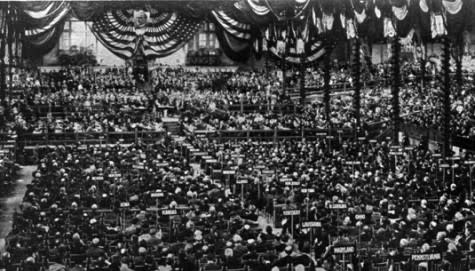10 highlights from political conventions hosted in Philadelphia
This week, the Democrats meet in Philadelphia for their national convention. And in its history as a convention host, the City of Brotherly Love has witnessed its share of controversy.
The 1900 convention introduced Teddy Roosevelt as VP
Philadelphia only trails Chicago as the most popular major-party convention spot in American history. The Windy City, with its central location, has hosted 26 conventions. (The last Chicago national convention was in 1996.) Philadelphia has hosted 13 gatherings. Baltimore also has hosted 13 major conventions (8 for the Democrats, 3 for the GOP, 2 for the Whigs), but the last time it hosted a big convention was in 1912.
Past conventions in Philadelphia included a cast of characters such as Zachary Taylor, Theodore Roosevelt, Franklin Roosevelt, Thomas Dewey and the Know Nothings.
1848: The Whigs land in Philly
In 1848, the Whigs had their national convention at Philadelphia’s Chinese Museum. The Whig front-runner was an independent, General Zachary Taylor. He ran for the White House as a Whig, due partly to his dislike of outgoing President James K. Polk. Taylor prevailed over Henry Clay on the fourth ballot.
1856: The Know Nothings last convention
The Know Nothings were an anti-immigrant nativist party. The party doctrine stood firmly against Catholics and foreigners, and its members had some regional election success in the 1850s. Former President Millard Fillmore won a first ballot nomination, with President Andrew Jackson’s nephew, Andrew Donelson, as his running mate. The Know Nothings did poorly in the 1856 election and they soon disappeared as a political factor.
1856: Abraham Who?
The Republican Party gathered at Philadelphia’s Musical Fund Hall on Locust Street in June 1856 to pick its first presidential candidate. The dashing John Fremont defeated 71-year-old Supreme Court Justice John McLean on the first ballot. In the vice presidential voting, former New Jersey Senator William Dayton was the nominee, defeating a lesser-known ex-Whig from Illinois named Abraham Lincoln.
1866: The National Union Mid-Term Convention
This unusual gathering was called during the crucial 1866 election cycle, where the fate of Reconstruction was in the balance. The August 1866 meeting of the National Union Party’s remnants in Philadelphia was an attempt by President Andrew Johnson to unite conservative Republicans with Democrats, in his fight with the Radical Republicans. Emboldened by the convention, Johnson took his party leaders on a whirlwind speaking tour. The “Swing Around The Circle” tour would start near Philadelphia, but it led to disaster and huge losses in the election.
1872: Grant nominated and Republican Vice Presidential drama
There were three days of celebrations at the Academy of Music with no opposition to the nomination of President Ulysses S. Grant. However, there was considerable debate about incumbent Vice President Schuyler Colfax, who has dumped at the convention for Henry Wilson of Massachusetts as Grant’s running mate.
1900: Theodore Roosevelt takes the national stage
In June 1900, the Republicans gathered at a large temporary auditorium near Philadelphia’s Schuylkill River to approve a second term for William McKinley, who had defeated William Jennings Bryan four years earlier. But McKinley’s Vice President, Garret Hobart, had died in November 1899, and there was much speculation about the next vice presidential nominee. New York Governor Theodore Roosevelt got the VP nod when other New York politicians thought it would be a good move to get Teddy out of New York state politics.
1936: Roosevelt swings the Democrats to the left
The Democratic Party convention itself lasted five days. President Roosevelt was acclaimed as the nominee, without opposition, in a voice vote. Roosevelt and James Farley, the Democratic National Committee chair, convinced state party leaders to endorse a “majority vote” system for future Democratic conventions, which took power away from conservative southern states in the party.
1940: A businessman takes the Republican nomination
Wendell Willkie’s win is considered one of the great surprises in political convention history. Willkie had been considered a 3 percent favorite for the nomination just one month before the Philadelphia convention. A corporate attorney and utilities company president, Willkie had also fought with the FDR administration. And as Republican, Willkie gained a national following as he made speeches and earned the support of influential media figures who touted Willkie as a “fresh-faced” candidate. He won on the third ballot, defeating New York’s Thomas Dewey and Ohio’s Robert Taft.
1948: A Philadelphia triple header
Three of the four parties that fought in the bitter 1948 election met for their conventions in Philadelphia. The Republicans met first, without a preordained candidate. As in 1940 and 1944, New York Governor Thomas Dewey was the Republican convention favorite. Dewey was able to lock up the nomination again on the third ballot after the anti-Dewey coalition couldn’t agree on a compromise ticket. Then the Democrats nominated the incumbent President Harry Truman – who was expected to lose in the general election. The Democrats also approved a pro-Civil Rights platform, which led to the walkout of conservative southern Democrats. Finally, the Progressive Party, nominated Henry Wallace, the former Roosevelt Vice President who Truman had replaced on the 1944 ticket.
2000: A rather uneventful Republican convention
The GOP returned to Philadelphia for the first time since 1948 and the party’s convention lacked the drama of other national gatherings in the City of Brotherly Love. George W. Bush had won the primary campaign and selected Richard Cheney as his running mate. At the convention, the party promoted a message of compassionate conservatism and criticized the Clinton administration.
Recent Stories on Constitution Daily
U.S. seeks nationwide advice on birth-control dispute
Looking back: The Supreme Court decision that ended Nixon’s presidency
Why does a presidential candidate need to be 35 years old anyway?


